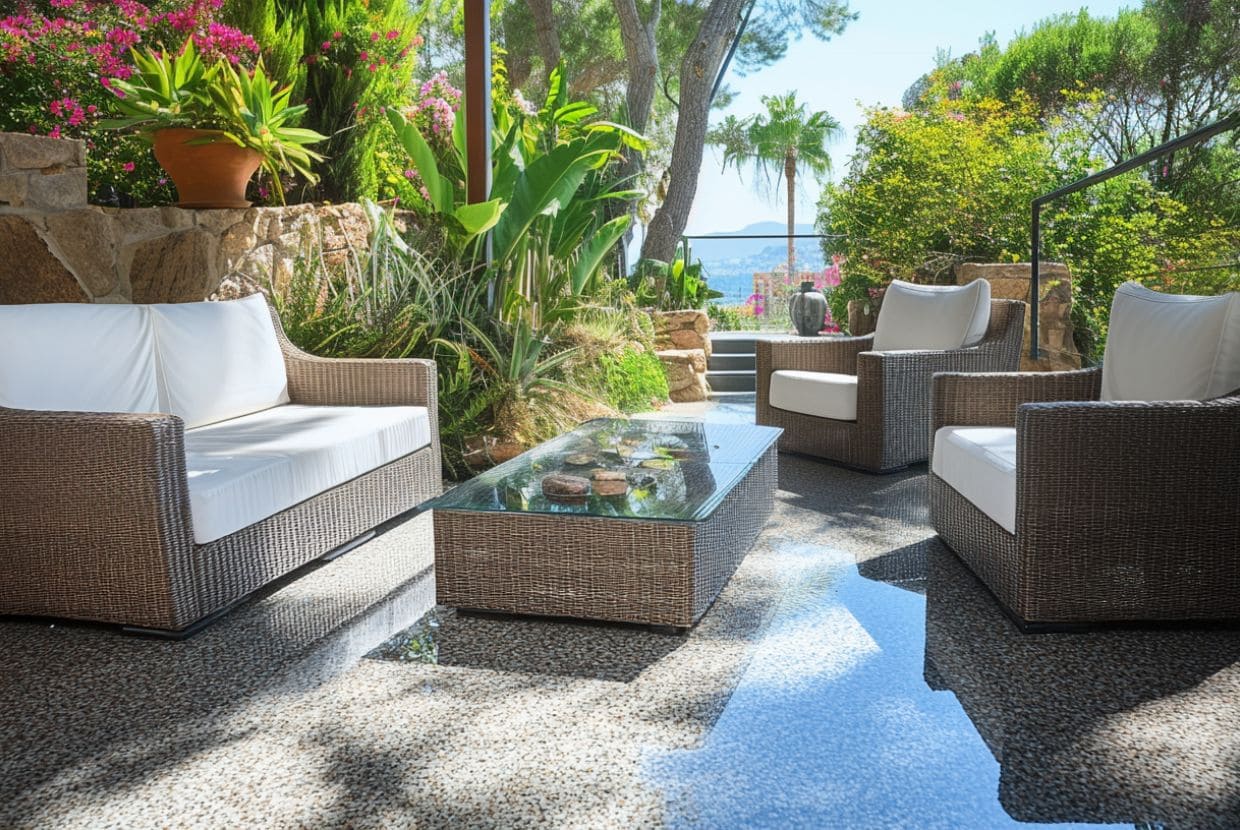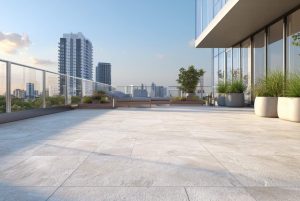Although Mallorca is a dreamy paradise and a jewel in the Mediterranean, geographically it presents a silent and significant challenge for outdoor flooring: persistent humidity, corrosive saltpeter, and abrasive sand. Without a doubt, each of these factors, combined with the warm climate and salty breezes, accelerates the deterioration of pavements and terraces. Furthermore, this damage not only compromises aesthetics but also safety and functionality. For this reason, we're going to talk about how to restore outdoor flooring without failing.
Learn all the details on this topic here!
Factors that Damage Outdoor Soils in Coastal Areas
In Mallorca, we live with natural agents that, without proper care, can become silent enemies of outdoor soils.
These factors not only affect the aesthetics of outdoor spaces, but also compromise their safety, functionality, and durability. However, there are steps to restore outdoor flooring that significantly address this issue.
The action of saltpeter and humidity
Saltpeter and humidity are the main enemies of coastal soils, their main consequences being:
- Corrosion: for metallic materials (joints, gratings) and mortars, which generates rust and disintegration.
- Efflorescence: On limestone, terrazzo or concrete floors, white spots appear due to the crystallization of salts on the surface.
- Detachments: Inside tiles or pavements, saltpeter weakens the adhesive layers, causing cracks.
Effects of humidity
- Swelling and cracking: In untreated wood (such as pine or teak), moisture penetrates, warping boards and rotting fibers.
- Proliferation of microorganisms: moss, algae, and mold grow on damp surfaces, creating slippery and unsightly areas.
Effects of wind and sand on wear
When we don't know how to restore outdoor floors, it's important to know that the coastal wind carries sand and dust particles, which act as a constant sanding on the floors, which is important when knowing how to restore outdoor floors:
Surface abrasion
- On microcement, wood, or glossy ceramic floors, sand creates micro-scratches that dull the finish.
- In porous pavements, sand becomes embedded, accelerating wear.
Erosion of joints and seals
Mortar or silicone joints weaken, allowing water and saltpeter to enter.
How to Restore Outdoor Flooring? Techniques and Materials
When wondering how to restore exterior flooring damaged by the coastal climate, techniques such as polishing with diamond discs, renewing joints with epoxy or polyurethane resins, and using varnishes with quartz particles are essential.
These solutions not only revive aesthetics but also strengthen surfaces against moisture, wind, and wear, ensuring durability in demanding environments like Mallorca. Investing in these professional methods ensures functional, safe, and visually impeccable floors.
Polishing and vitrifying methods for exteriors
Restoring an outdoor floor in coastal areas like Mallorca requires specialized methods that combat wear and tear caused by salt, moisture, and sand.
The process begins with polishing with diamond discs, ideal for concrete or natural stone floors, removing eroded layers and restoring surface smoothness.
A glaze is then applied with acrylic or epoxy resins, which not only restores the lost shine but also creates a barrier against UV rays and sand abrasion.
Application of sealants and waterproofing
To ensure comprehensive protection, it is crucial to include the application of sealants and waterproofing:
- Nanoporous sealants: They block the absorption of saltpeter and moisture in porous materials (terrazzo, brick), preventing cracks and efflorescence, ideal when you are wondering how to restore an outdoor floor.
- Siloxane-based waterproofing: They reinforce joints and cracks, preventing leaks in wood or composite floors.
These techniques, combined with high-resistance varnishes, not only restore the original aesthetics but also extend the life of the floor.
Preventive Maintenance and Care Tips
Knowing how to restore an outdoor floor begins with proper preventative maintenance, especially in coastal areas like Mallorca, where salt, humidity, and sand accelerate deterioration. These tips and routines will help you preserve your floors and reduce the need for extensive restorations:
Specific cleaning routines for coastal areas
Daily/Weekly Cleaning:
- Sweep with a soft-bristled broom to remove sand and dust, avoiding scratches.
- On wooden decks, use outdoor vacuums that don't stir up abrasive particles.
Monthly cleaning:
- Low-pressure hydro-washing with warm water and neutral detergent (pH 7).
- On stone floors, apply anti-limescale descaler to remove encrusted saltpeter.
Recommended products and seasonal care
For stone/concrete floors:
- Nanoporous sealants: repel salt and moisture without altering the texture.
- Anti-algae detergents: prevent moss in shady areas.
For wood:
- Oils with UV filters: protect against sun and salt.
- Quartz varnishes: resist sand abrasion.
For joints and cracks:
- Marine epoxy resins
Frequently Asked Questions about Outdoor Floor Restoration Using Polishing and Glazing
How often should restoration be performed?
The frequency depends on the material and exposure to coastal climate.
Is it possible to restore all types of floors?
Yes, restoring an outdoor floor is feasible with materials such as concrete, natural stone (marble, granite), terrazzo, treated wood, composite, and brick, using techniques such as polishing, vitrification, or sealing.
However, it is not recommended for severely cracked ceramic floors, rotten wood, or UV-degraded synthetic floors, where restoration may be temporary or impossible.
What results can you expect after treatment?
By applying techniques such as polishing, vitrification, and professional sealing, these are restored to their original aesthetic (eliminating scratches, moisture stains, and efflorescence).
When faced with the challenge of restoring an outdoor floor, these techniques provide enhanced protection against salt, sand, and UV rays, and improve safety with non-slip surfaces in wet areas.
At Projectes Sastre: Your Expert in Outdoor Floor Restoration
We are experts in restoring life to outdoor floors damaged by salt, moisture, and sand. If your patio floor is made of wood, marble, terrazzo, granite, concrete, hydraulic tiles, or stone paving and looks worn, cracked, or dull, our professional polishing and vitrification treatments are the answer.
At Projectes Sastre, we specialize in floor polishing and vitrification in Mallorca. Contact us so we can advise you personally and send you a customized, no-obligation quote. We look forward to hearing from you!




